How does Lactobacillus buchneri reduce aerobic spoilage?
This is a species of heterofermentative lactic acid bacteria. During the initial fermentation it competes with homofermentative lactic acid bacteria and converts sugars to a mixture of end products, including acetic acid, something which will reduce the rate of pH fall as well as increase fermentation dry matter losses, neither of which are desirable. But this unusual species can also convert lactic acid into acetic acid and 1,2-propanediol. This results in a silage with a significantly higher acetic acid level than normal and, as acetic acid is inhibitory to the yeasts and moulds that cause aerobic spoilage, it is less likely to heat and go mouldy at feedout. These activities will increase fermentation DM losses but the potential savings in reduced aerobic DM losses should more than make up for this.
 Although 1,2-propanediol is not an acid and has no anti-fungal properties, there are bacteria on forages that can convert it to a mixture of propionic acid and 1-propanol. Propionic acid is an even better anti-fungal agent that acetic acid.
Although 1,2-propanediol is not an acid and has no anti-fungal properties, there are bacteria on forages that can convert it to a mixture of propionic acid and 1-propanol. Propionic acid is an even better anti-fungal agent that acetic acid.

_copy_listing.png?1521897389)
